Performance and Verification of High-Modulus Asphalt Modified by Styrene-Butadiene-Styrene Block Copolymer (SBS) and Rock Asphalt
Abstract
1. Introduction
2. Materials and Experimental
2.1. Raw Materials
2.2. Preparation of High-Modulus Asphalt
2.3. Mixture Design
2.4. Test Methods
2.4.1. Softening Point, Penetration, Ductility and Viscosity Tests
2.4.2. Segregation Softening Point Test
2.4.3. Dynamic Shear Rheometer (DSR)
2.4.4. Bending Beam Rheometer (BBR)
2.4.5. Pneumatic Rheological Rebound Test
3. Results and Discussions
3.1. Penetration, Softening Point, Ductility and Viscosity Index
3.2. Thermal Storage Stability of Asphalt
3.3. Analysis on Rheological Properties of Asphalt
3.3.1. High-Temperature Rheological Properties
3.3.2. Low-Temperature Rheological Properties
3.3.3. Pneumatic Rheological Rebound Performance
3.3.4. Multivariate Analysis
3.4. Performance Verification of Composite Modified Asphalt Mixture
4. Conclusions
Author Contributions
Funding
Institutional Review Board Statement
Informed Consent Statement
Data Availability Statement
Conflicts of Interest
References
- Shen, J.; Li, F.; Chen, J. Early Damage and Preventive Measures of Highway Asphalt Pavement; People’s Communications Press: Beijing, China, 2004. [Google Scholar]
- Wang, Z. Research on New Preventive Maintenance Technology of Asphalt Pavement Based on Lateral Redistribution of Traffic Load; Chang’an University: Xi’an, China, 2012. [Google Scholar]
- Song, X.; Fan, L.; Shen, Q. Research on road performance of domestic natural rock asphalt modified asphalt mixture. Highway 2009, 12, 135–139. [Google Scholar]
- Bai, M.; Jiang, H.; Ma, Q. Application of hard asphalt mixture in overhaul of national and provincial trunk highways. Theor. Res. Urban Constr. 2019, 13, 125–126. [Google Scholar] [CrossRef]
- Yu, P. Development and Application of Special Hard Asphalt for High Modulus Asphalt Mixtures; Chang’an University: Xi’an, China, 2014. [Google Scholar]
- Gu, S.; Sun, X.; Han, P. Application of low-grade hard asphalt particles in high-modulus asphalt mixture. Pet. Asph. 2014, 28, 42–45. [Google Scholar]
- Shi, X.; Yang, J.; Chen, X. Study on high and low temperature performance of high modulus asphalt mixture. China Foreign Highw. 2013, 33, 309–312. [Google Scholar]
- Huang, H. Influence of direct injection high modulus modifier dosage on road performance of asphalt mixture. Transp. World. 2021, 79, 4–6. [Google Scholar]
- Guan, Z.; Liu, X.; Li, S.; Wu, C.; Xu, X.; Cheng, S. Study on high temperature properties of high modulus modified asphalt binder and mixture. Guangdong Highw. Transp. 2020, 46, 1–6. [Google Scholar]
- Yang, P. Research on the Characteristics of High Modulus Asphalt and Its Mixture; South China University of Technology: Guangzhou, China, 2012. [Google Scholar]
- Wei, O. Research on Anti-Rutting Performance of High Modulus Asphalt Concrete; Northeastern University: Shenyang, China, 2010. [Google Scholar]
- Zhang, Q.; Fan, W.; Wang, T.; Nan, G. Research on the properties and microstructure of SBS modified AH-70 asphalt before and after emulsification. J. China Univ. Pet. 2011, 35, 146–151. [Google Scholar]
- Liu, S. Theoretical Research on Buton Rock Asphalt Modified Asphalt Mixture and Asphalt Mixture Proportion Design; Tongji University: Shanghai, China, 2006. [Google Scholar]
- Zou, G.; Li, W.; Xu, J. Research on low temperature rheological behavior of low-grade asphalt mortar. Zhong Wai Highw. 2014, 34, 210–214. [Google Scholar] [CrossRef]
- Yu, S.J. Production and Application of No. 30 Hard Asphalt. Pet. Asph. 2013, 27, 45–49. [Google Scholar]
- Du, S.W. Properties and mechanism of rock asphalt SBS composite modified asphalt mixture. J. Build. Mater. 2012, 15, 871–874. [Google Scholar]
- Lu, M.; Jiang, Y.; Chen, J. Research on high-performance asphalt mixture modified by SBS + rock asphalt. Urban Roads Bridges Flood Control 2011, 12, 135–138+5. [Google Scholar] [CrossRef]
- Wang, S. Research on Road Performance of Qingchuanyan Asphalt/SBR Composite Modified Asphalt and Its Mixture; Chongqing Jiaotong University: Chongqing, China, 2019. [Google Scholar]
- Yang, Y. Research on the Technical Performance of Qingchuan Rock Asphalt Modified Asphalt and Its Mixture; Zhengzhou University: Zhengzhou, China, 2017. [Google Scholar]
- Tao, Z. Research on the Application Technology of North American Rock Asphalt/SBS Composite Modified Asphalt; South China University of Technology: Guangzhou, China, 2015. [Google Scholar]
- Bulgis; Tjaronge, M.W.; Adisasmita, S.A.; Hustim, M. Effect of Buton granular asphalt on compressive stress-strain behavior of asphalt emulsion mixture. IOP Conf. Ser. Mater. Sci. Eng. 2017, 271, 012069. [Google Scholar] [CrossRef]
- Suaryana, N. Performance evaluation of stone matrix asphalt using Indonesian natural rock asphalt as stabilizer. Int. J. Pavement Res. Technol. 2016, 9, 387–392. [Google Scholar] [CrossRef]
- Li, R.X.; Karki, P.; Hao, P.; Bhasin, A. Rheological and low temperature properties of asphalt composites containing rock asphalts. Constr. Build. Mater. 2015, 96, 47–54. [Google Scholar] [CrossRef]
- Huang, G.; He, Z.; Zhang, Z.; Yang, Y. Research on the performance of asphalt modified mixture against rutting rock. China Foreign Highw. 2009, 29, 187–192. [Google Scholar]
- Li, R.X.; Hao, P.W.; Wang, C. Performance Evaluation of BRA Modified Asphalt Based on Analysis of Rheological Property. Adv. Mater. Res. 2012, 374–377, 1385–1390. [Google Scholar]
- JTG E20-2011; Highway Engineering Asphalt and Asphalt Mixture Test Regulations. People’s Communications Press: Beijing, China, 2011.
- SH/T 1610-2011; Thermoplastic Elastomer Styrene-Butadiene Block Copolymer (SBS). People’s Communications Press: Beijing, China, 2013.
- JTG F40-2004; Technical Specification for Highway Asphalt Pavement Construction. People’s Communications Press: Beijing, China, 2004.
- Cai, H.; Xu, J.; Liu, Y.; Mei, S. Study on the correlation between high temperature index of asphalt and its high temperature road performance. New Build. Mater. 2011, 38, 65–68. [Google Scholar]
- Asphalt Institute. Superpave Mix Design, Superpave Series No.2 (SP-2); Federal Highway Administration: Frankfort, KY, USA, 2003. [Google Scholar]
- GB/T 36143-2018; Durable High Modulus Asphalt Mixture for Road Engineering. People’s Communications Press: Beijing, China, 2013.

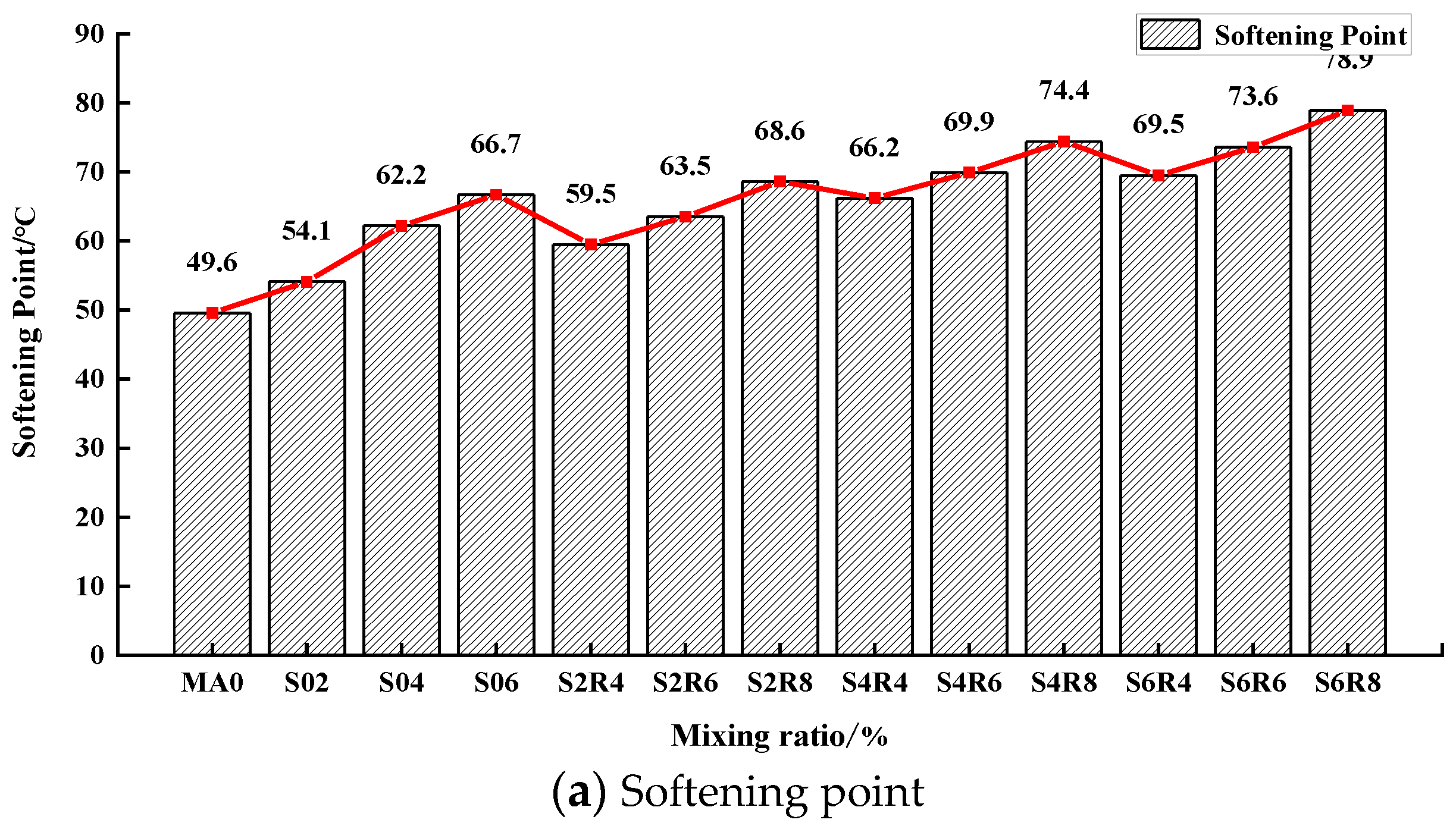

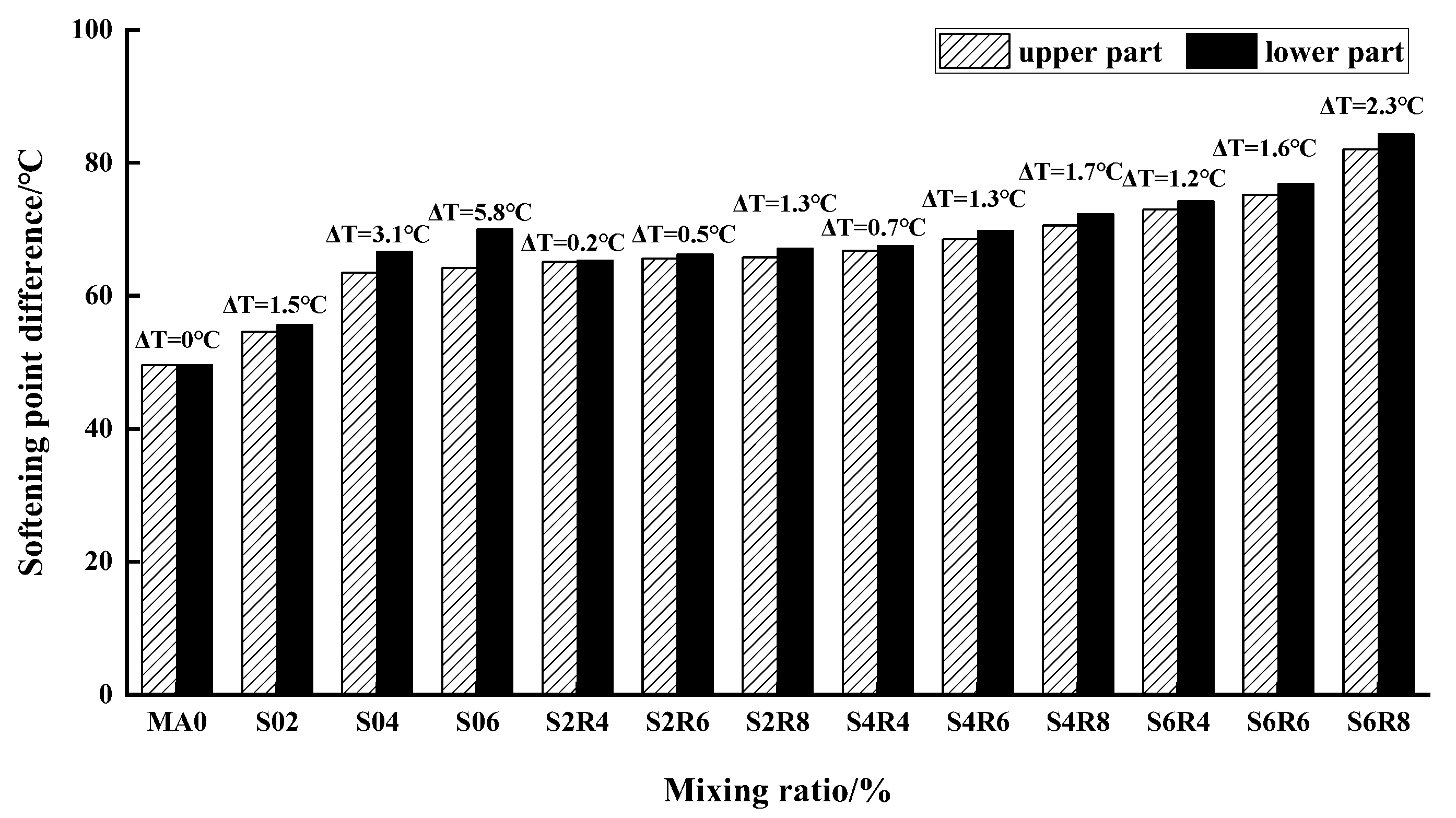
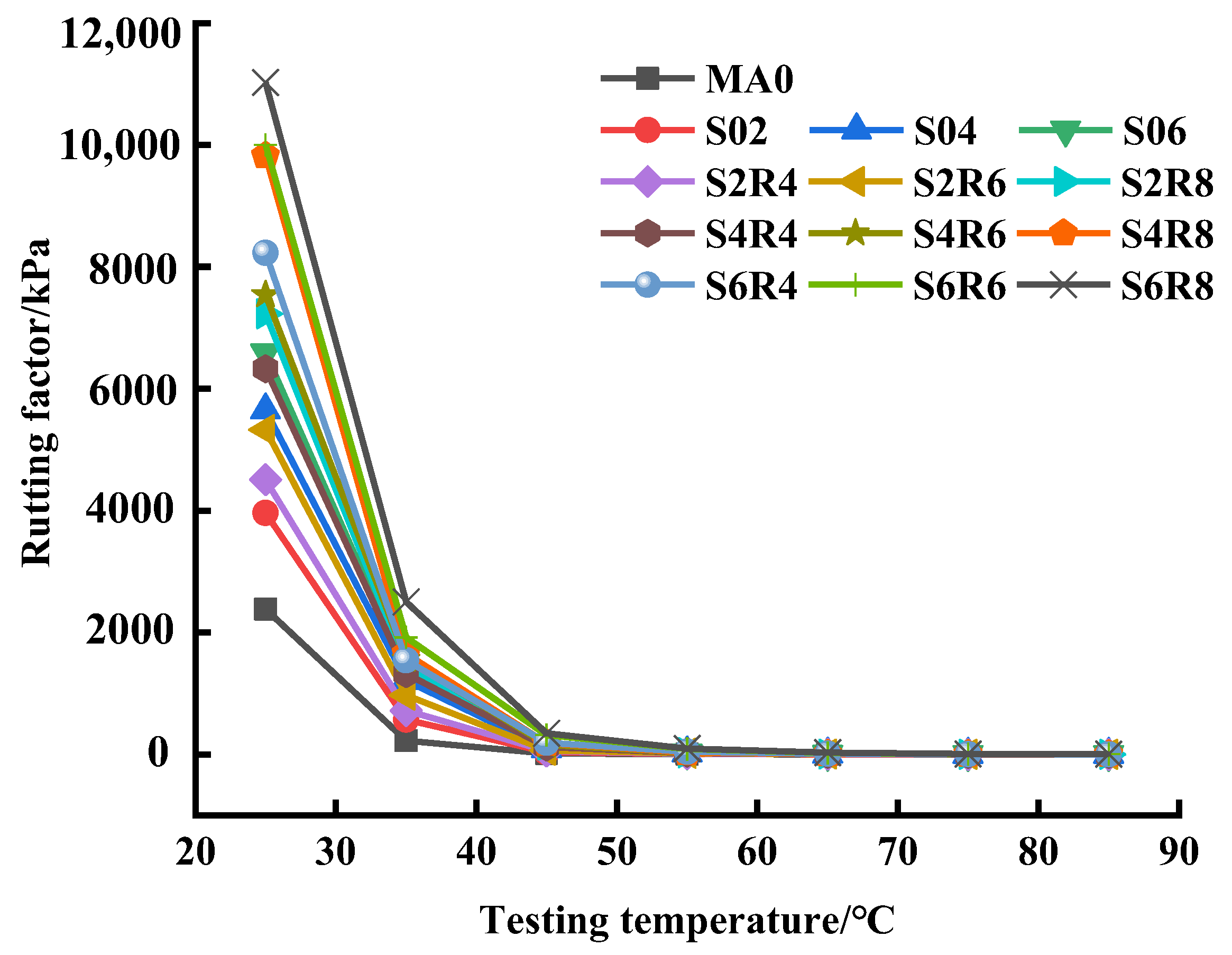
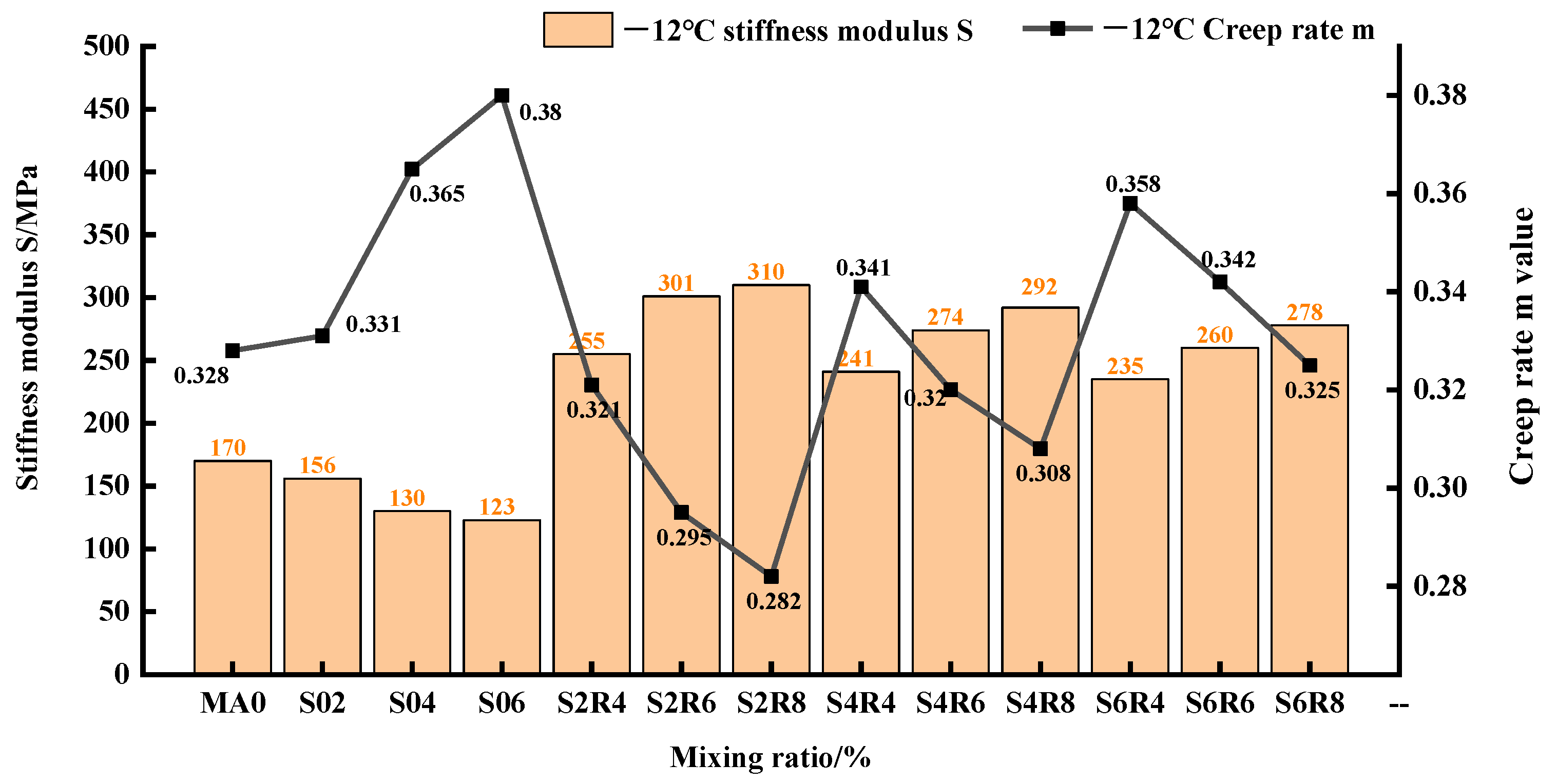
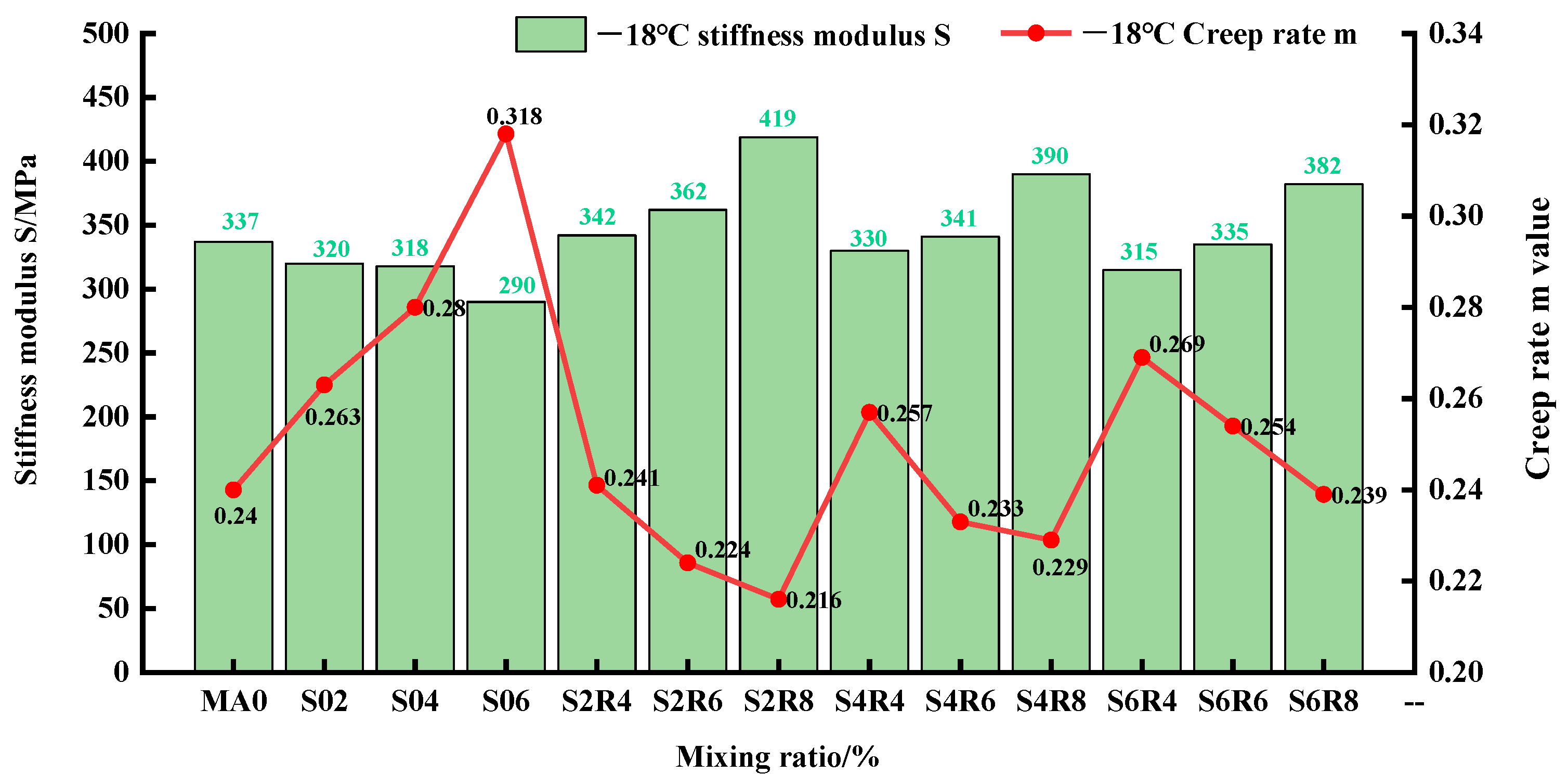
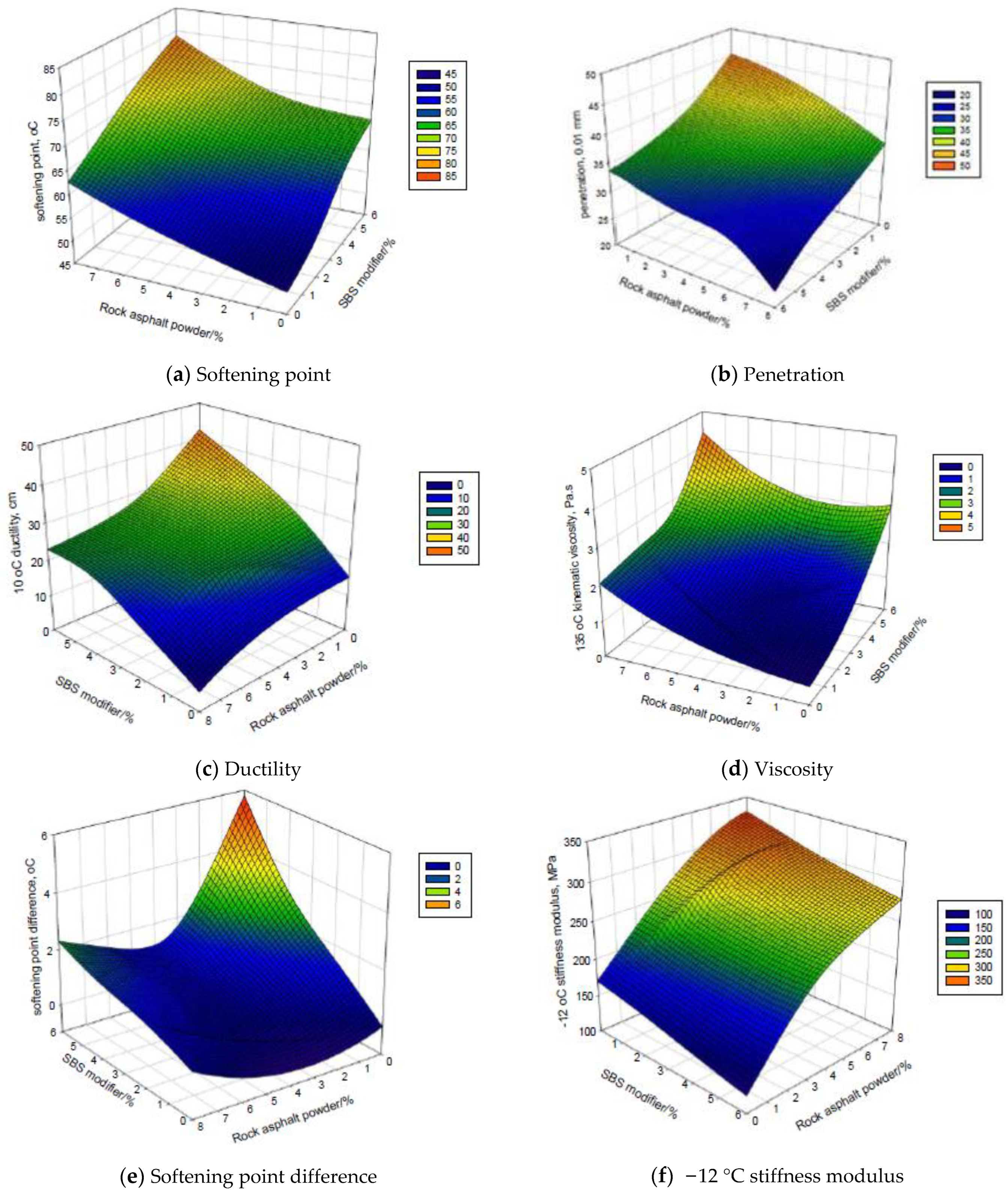
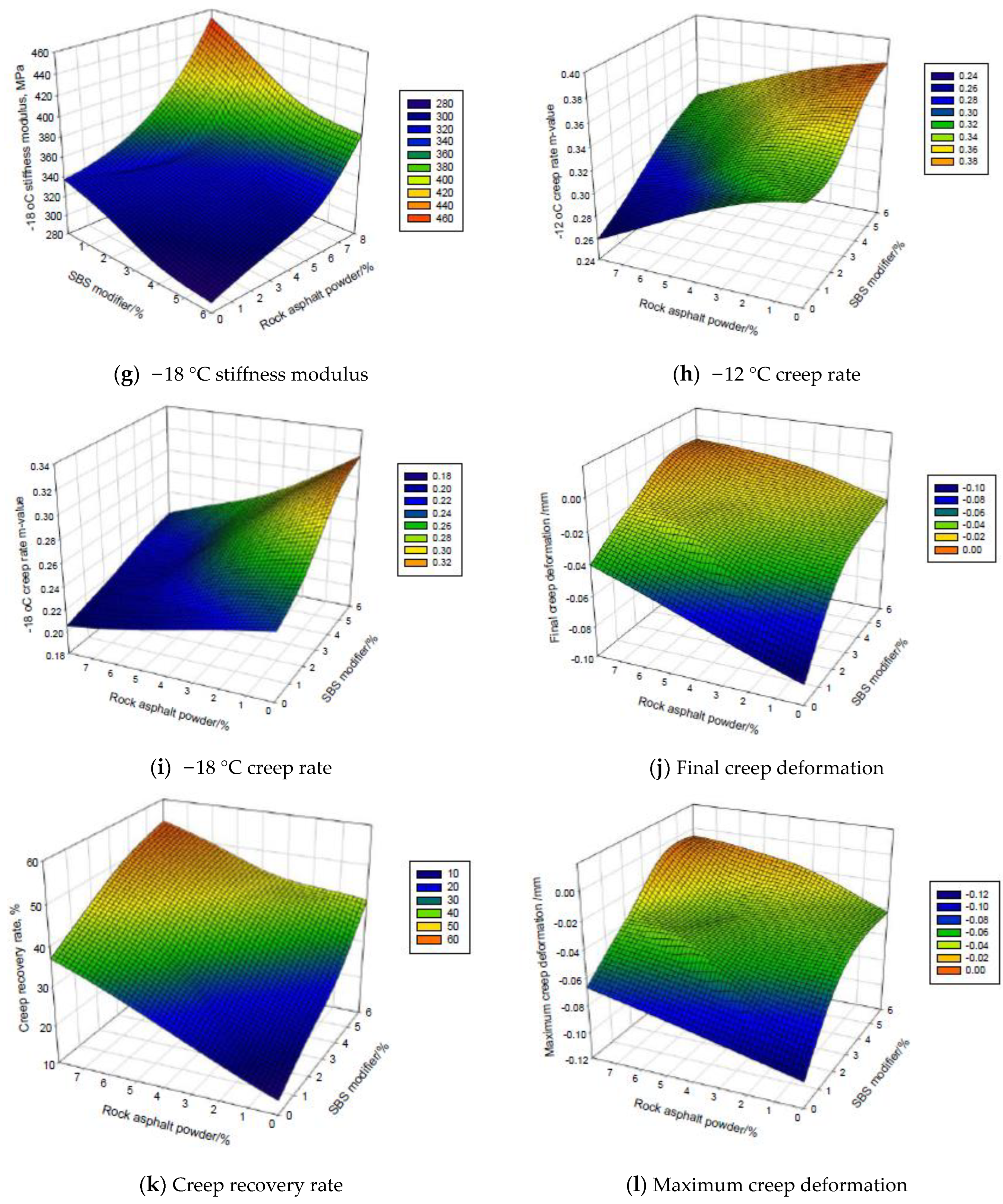
| Test Project | Test Values | Threshold Values |
|---|---|---|
| Softening point/°C | 49.6 | 45~60 |
| Penetration/mm | 45.3 | 40~60 |
| Ductility (10 °C)/cm | 15.2 | ≥15 |
| 135 Brookfield viscosity/Pa.s | 0.5 | <3.0 |
| RTFOT ductility (15 °C)/cm | 10.1 | ≥10 |
| Test Project | Structure | Volatile/% | Styrene Content/% | Molecular Weight/10,000 | Melt Mass Flow Rate (MFR)/ (g/10 min) | Tensile Strength/MPa | 300% Constant Elongation Stress/MPa | Elong-ation at Break/% | Yellow Index | Else |
|---|---|---|---|---|---|---|---|---|---|---|
| Test values | Linear type | 0.4 | 40 | 15 | 0.09 | 21.4 | 3.1 | 736 | 0.6 | Unsaturated |
| Test Project | Color | Density/g.cm−3 | Softening Temperature/°C | Asphalt Content (Combustion Method)/% | Water Content/% | Ash Content/% |
|---|---|---|---|---|---|---|
| Test values | Black-brown | 1.18 | 175 | 86.6 | 0.8 | 8 |
| Sample | SBS Modifier/% | Rock Asphalt Powder/% |
|---|---|---|
| MA0 | 0 | 0 |
| S02 | 2 | 0 |
| S04 | 4 | 0 |
| S06 | 6 | 0 |
| S2R4 | 2 | 4 |
| S2R6 | 2 | 6 |
| S2R8 | 2 | 8 |
| S4R4 | 4 | 4 |
| S4R6 | 4 | 6 |
| S4R8 | 4 | 8 |
| S6R4 | 6 | 4 |
| S6R6 | 6 | 6 |
| S6R8 | 6 | 8 |
| Seive Size (mm) | 31.5 | 26.5 | 19 | 16 | 13.2 | 9.5 | 4.75 | 2.36 | 1.18 | 0.6 | 0.3 | 0.15 | 0.075 |
|---|---|---|---|---|---|---|---|---|---|---|---|---|---|
| Upper limit | 100 | 100 | 100 | - | - | 82.0 | 64.0 | 43.0 | - | - | - | - | 8.0 |
| Lower limit | 100 | 100 | 90.0 | - | - | 66.0 | 41.0 | 28.0 | - | - | - | - | 6.0 |
| Design median | 100 | 100 | 95.0 | - | - | 74.0 | 52.5 | 35.5 | - | - | - | - | 7.0 |
| Synthetic grading | 100 | 100 | 93.8 | 88.5 | 82.1 | 71.4 | 46.6 | 32.4 | 26.2 | 17.6 | 13.0 | 8.4 | 6.3 |
| Samples | Final Creep Deformation/mm | Creep Recovery Rate/% | Maximum Creep Deformation/mm | PG |
|---|---|---|---|---|
| MA0 | −0.0868 | 13.7 | −0.1006 | PG 70-22 |
| S02 | −0.0446 | 21.3 | −0.0567 | PG 70-22 |
| S04 | −0.0304 | 28.3 | −0.0424 | PG 76-28 |
| S06 | −0.0252 | 40.9 | −0.0426 | PG 76-28 |
| S2R4 | −0.0319 | 32.4 | −0.0472 | PG 76-22 |
| S2R6 | −0.0237 | 39.8 | −0.0394 | PG 76-16 |
| S2R8 | −0.0216 | 44.2 | −0.0387 | PG 76-16 |
| S4R4 | −0.0221 | 41.9 | −0.0380 | PG 76-22 |
| S4R6 | −0.0193 | 46.6 | −0.0361 | PG 82-22 |
| S4R8 | −0.0043 | 50.5 | −0.0087 | PG 82-22 |
| S6R4 | −0.0087 | 44.8 | −0.0158 | PG 82-22 |
| S6R6 | −0.0049 | 49.9 | −0.0098 | PG 82-22 |
| S6R8 | −0.0027 | 54.2 | −0.0059 | PG 82-22 |
| Technical Index | Requirements | Test Results | ||||
|---|---|---|---|---|---|---|
| MA0 | S4R6 | S4R8 | S6R6 | S6R8 | ||
| Void ratio/% | ≤4 | 3.46 | 3.52 | 3.50 | 3.55 | 3.45 |
| Freeze-thaw splitting tensile strength/% | ≥80 | 79.8 | 86.5 | 88.5 | 88.4 | 87.6 |
| 60 °C dynamic stability times/mm | ≥4000 | 3150 | 4117 | 4345 | 4200 | 4375 |
| Dynamic modulus (45 ± 0.5 °C, 10 ± 0.1 Hz)/MPa | ≥4000 | 3250 | 4010 | 4080 | 4040 | 4150 |
| Fatigue life (15 ± 0.5 °C, 10 ± 0.1 Hz, 230 με)/cycles | ≥106 | 865,245 | 2,424,220 | 2,362,530 | 2,260,360 | 2,116,500 |
| Low-temperature bending test failure strain (−10 ± 0.5 °C)/με | ≥2000 | 1864.56 | 2510.60 | 2493.98 | 2385.16 | 2149.32 |
Disclaimer/Publisher’s Note: The statements, opinions and data contained in all publications are solely those of the individual author(s) and contributor(s) and not of MDPI and/or the editor(s). MDPI and/or the editor(s) disclaim responsibility for any injury to people or property resulting from any ideas, methods, instructions or products referred to in the content. |
© 2022 by the authors. Licensee MDPI, Basel, Switzerland. This article is an open access article distributed under the terms and conditions of the Creative Commons Attribution (CC BY) license (https://creativecommons.org/licenses/by/4.0/).
Share and Cite
Li, Y.; Yan, X.; Guo, J.; Wu, W.; Shi, W.; Xu, Q.; Ji, Z. Performance and Verification of High-Modulus Asphalt Modified by Styrene-Butadiene-Styrene Block Copolymer (SBS) and Rock Asphalt. Coatings 2023, 13, 38. https://doi.org/10.3390/coatings13010038
Li Y, Yan X, Guo J, Wu W, Shi W, Xu Q, Ji Z. Performance and Verification of High-Modulus Asphalt Modified by Styrene-Butadiene-Styrene Block Copolymer (SBS) and Rock Asphalt. Coatings. 2023; 13(1):38. https://doi.org/10.3390/coatings13010038
Chicago/Turabian StyleLi, Yuxin, Xiangpeng Yan, Jianmin Guo, Wenjuan Wu, Wencheng Shi, Qinsheng Xu, and Zhengjun Ji. 2023. "Performance and Verification of High-Modulus Asphalt Modified by Styrene-Butadiene-Styrene Block Copolymer (SBS) and Rock Asphalt" Coatings 13, no. 1: 38. https://doi.org/10.3390/coatings13010038
APA StyleLi, Y., Yan, X., Guo, J., Wu, W., Shi, W., Xu, Q., & Ji, Z. (2023). Performance and Verification of High-Modulus Asphalt Modified by Styrene-Butadiene-Styrene Block Copolymer (SBS) and Rock Asphalt. Coatings, 13(1), 38. https://doi.org/10.3390/coatings13010038





